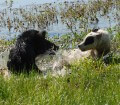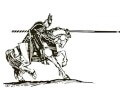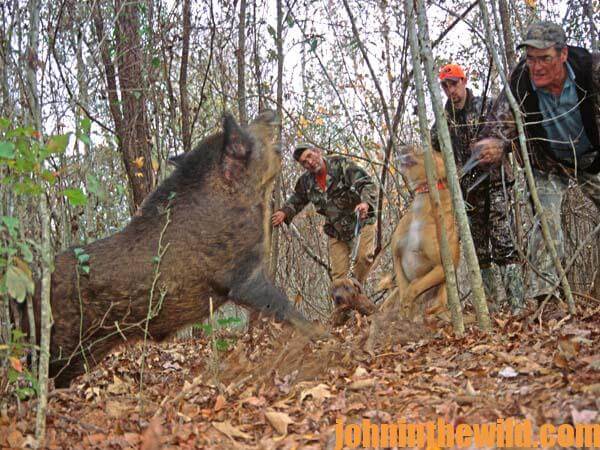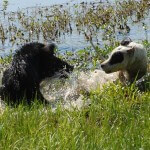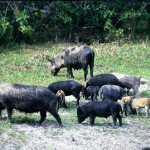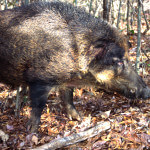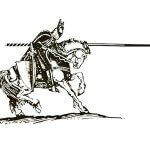John’s Note: Hunting savage wild hogs with a spear is a dangerous sport and has a history almost as old as mankind itself.
The hunt went on, and shortly we cornered a second hog – a trophy boar weighing over 200 pounds with sharp tusks and a huge head.
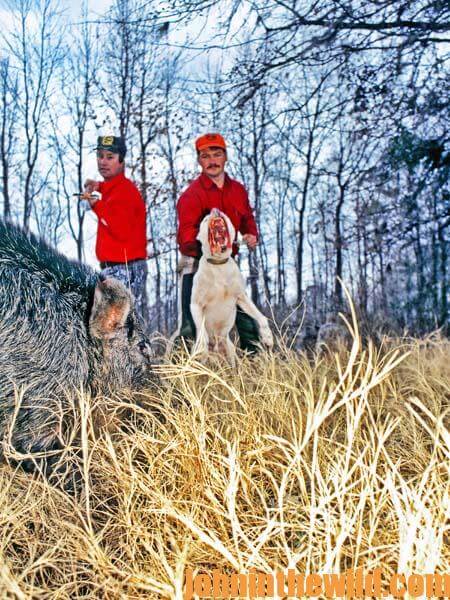 If the dogs had not been courageous, and if Helmly had not been skillful, the animal could have wreaked havoc with our hunting party. “John, if I release this hog, and you try and kill him with that spear, one of three things will happen,” Helmly explained. “Since you don’t have room to maneuver, the hog probably will cut you. If he doesn’t cut you, he will cut up one of my dogs. If you or the dogs miss injury, somebody in this party will receive a bad gash and/or an injury that may have been avoided. Take the hog now if you want to while I hold him, but I’m not going to stand by and watch somebody get hurt.”
If the dogs had not been courageous, and if Helmly had not been skillful, the animal could have wreaked havoc with our hunting party. “John, if I release this hog, and you try and kill him with that spear, one of three things will happen,” Helmly explained. “Since you don’t have room to maneuver, the hog probably will cut you. If he doesn’t cut you, he will cut up one of my dogs. If you or the dogs miss injury, somebody in this party will receive a bad gash and/or an injury that may have been avoided. Take the hog now if you want to while I hold him, but I’m not going to stand by and watch somebody get hurt.”
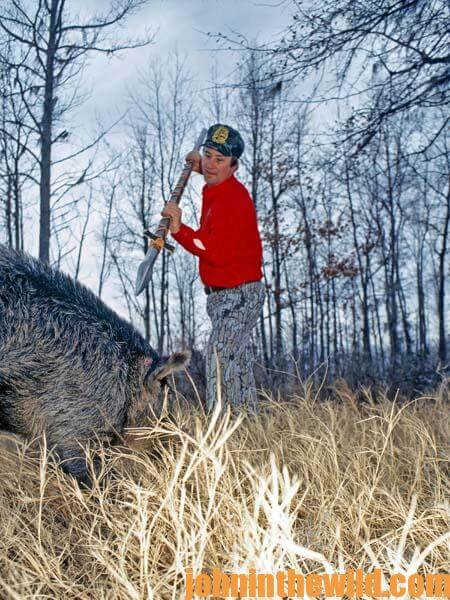 Yielding to Helmly’s wisdom, I lunged with all the power I could muster to drive the blade of the spear between the boar’s two front shoulders, which was when reality replaced ambition. I had wrongly assumed there was a soft spot between the two thick, gristled shields that protected the animal’s vital organs. Like the matador who would drive a sword between a bull’s shoulders and put the animal down instantly and quickly, I thought I could drive the spear between the boar’s shoulders and down him very effectively. Mistakenly, I thought the target was 2- to 4-inches wide. Actually the gap between the two formidable shields of the wild boar when he was standing or running was often no more than 1/2- to 1/4-inch wide. Even if the boar was hit, the shield would pinch together to prevent the spear from penetrating. I had spent hours with a grinding stone and a whetstone to be certain the spear was sharp, but when I tried to drive it home, it hit the hog’s armor plates and penetrated no more than 1/8-inch.
Yielding to Helmly’s wisdom, I lunged with all the power I could muster to drive the blade of the spear between the boar’s two front shoulders, which was when reality replaced ambition. I had wrongly assumed there was a soft spot between the two thick, gristled shields that protected the animal’s vital organs. Like the matador who would drive a sword between a bull’s shoulders and put the animal down instantly and quickly, I thought I could drive the spear between the boar’s shoulders and down him very effectively. Mistakenly, I thought the target was 2- to 4-inches wide. Actually the gap between the two formidable shields of the wild boar when he was standing or running was often no more than 1/2- to 1/4-inch wide. Even if the boar was hit, the shield would pinch together to prevent the spear from penetrating. I had spent hours with a grinding stone and a whetstone to be certain the spear was sharp, but when I tried to drive it home, it hit the hog’s armor plates and penetrated no more than 1/8-inch.
After the spear glanced off the pig’s shields, Helmly observed, “Fellow, you would have been in a world of hurt if I had let that hog go. I’ve seen hogs keep on running after being hit on the shoulder or between the shoulders with 00 buckshot. The only place you’ll probably be able to take the hog is to hit him under the throat.” Following Helmly’s instructions, I lunged again, this time for the boar’s throat. The Puma spear did the job it was designed to do. The blade went home. The tusker fell. “If that boar had charged, he would have hurt you real bad when you made your first lunge with the spear,” Helmly observed. “If you had tried to reach the hog’s throat before he got to you, chances are he would have knocked the spear out of the way, and you would have been cut. The only reasonable way a wild boar can and should be taken with a spear is the way we just took this one.” What a prize my wild boar was!
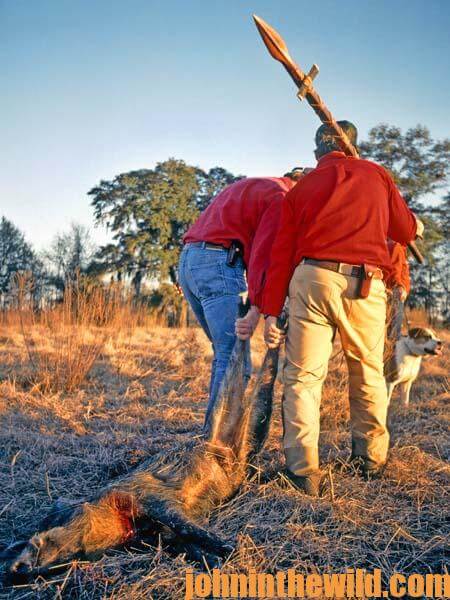 Although most of the heaviest wild boars ever taken came primarily from Texas, California, Alabama, Georgia, Louisiana and Florida also hold some wild boar weight records. The largest free-ranging wild boar was taken by four hunters in Texas in 2010 and weighed 789 pounds. Go to www.wwtworldrecords.com to learn more.
Although most of the heaviest wild boars ever taken came primarily from Texas, California, Alabama, Georgia, Louisiana and Florida also hold some wild boar weight records. The largest free-ranging wild boar was taken by four hunters in Texas in 2010 and weighed 789 pounds. Go to www.wwtworldrecords.com to learn more.
To learn more about all types of outdoor adventures, click here to get John E. Phillips’ print and Kindle books.

